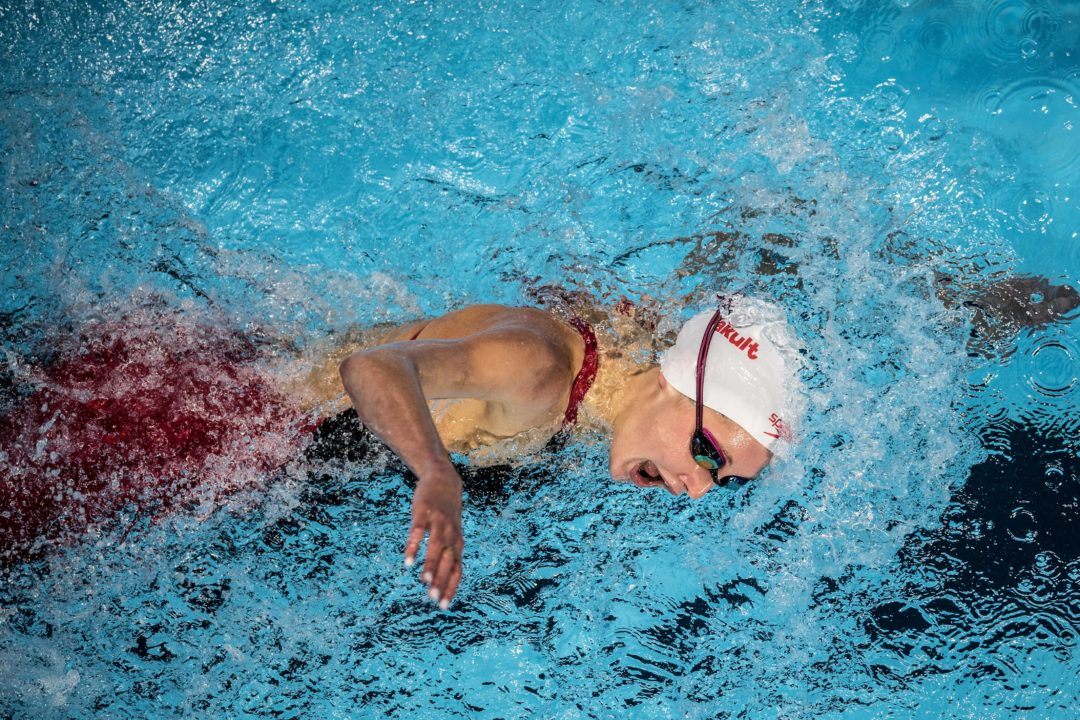TritonWear and SwimSwam bring you the best in swimming race analysis for the 2018 Commonwealth Games. With the power of TritonWear, you can access 12+ metrics for all athletes simultaneously, display the results in real-time to unlimited screens on deck, and review later in an easy to use interface for monitoring progress and identifying trends over time. See all Tritonwear Race Analysis here.
The women’s 200m freestyle featured an exciting battle between the podium finishers. Australia’s record holder Emma McKeon was in the race to defend her title against teammate and top seed, Ariarne Titmus, and Canada’s Taylor Ruck. Titmus and Ruck both finished under record time, but Ruck held Titmus off to win the gold, breaking her own Canadian record and setting a new Commonwealth Games record with her 1:54.81.
Ruck and McKeon had nearly identical speed and stroking metrics (Stroke count, DPS and Stroke Rate) for majority of the race. They matched each other stroke per stroke, pulling the same number of strokes in all but the first lap, where McKeon took one stroke more than Ruck. And, they both employed a similar strategy of producing higher DPS and stroke index, with a slower stroke rate.
McKeon started off strong, generating the fastest speed and clocking in the fastest split on the first 100 m. Her DPS and stroke index were below Ruck’s by a very thin margin, but she pulled at a faster rate, allowing her to take the early lead. Though still behind McKeon, Ruck began to gain ground on the second 50, matching McKeon in speed but pulling at a faster rate with a longer DPS. She was able to split the lap only a hundredth of a second behind McKeon.
Ruck’s more efficient strategy enabled her to have plenty of energy left at the halfway mark. She increased her stroke rate on the third lap, and continued to pull at an even faster rate off the final turn. Even though her DPS and stroke index simultaneously decreased, the efficiency loss on the final lap was very minimal, and her increased rate was enough to compensate for it.
Meanwhile, McKeon started to struggle maintaining her pace after the 100. Her overall speed decreased, and though this was the only lap where she pulled at a slightly higher DPS than Ruck, Ruck still had her beat when it came to overall stroke efficiency. She fell further behind on the final lap, pulling shorter strokes at a slower pace, giving Ruck a larger lead and Titmus the opportunity to pull ahead.
While McKeon and Ruck were battling it out with similar stroking strategies (stronger but slower, more efficient strokes) Titmus was trailing with the opposite strategy. She produced more strokes per lap, at a lower DPS, offsetting this with a faster stroke rate – resulting in a notably less efficient stroke index. While her stroking speed was significantly faster than Mckeon and Ruck’s, what made her performance truly impressive was how she was able to finish the race strong. She had conditioned herself for this mid-distance event well enough that even with a less efficient stroke, in the final stretch she still had the energy reserves to increase her stroke speed while maintaining a fairly consistent DPS and stroke index. This allowed her to lower the final split by over half a second, finishing with a silver medal.
Key Takeaways
This first analyzed race of these games highlight the importance of both consistency and proper pacing, based on an athletes specific strengths. Ruck and Titmus employed opposite strategies, but both swam the entire distance with fairly consistent metrics. Though Titmus’ strokes weren’t nearly as efficient as Ruck’s, and Ruck’s stroke rate wasn’t as fast as Titmus’, they were able to utilize each of their stronger metrics to their advantage.
Metric consistency goes hand in hand with proper pacing. McKeon started off strong, but her metrics saw a decline halfway through. On the other hand, Ruck and Titmus managed to keep their metrics stable, and off the final turn, they both had enough energy left in them to charge through the final lap with faster stroke rates and higher speed – to outsplit their competitor and take Gold and Silver.
To dive into the numbers of each athlete yourself, use the interactive board below to see exactly how they performed across all metrics.
There are 5 more days of thrilling races to come! Stay tuned for more race analysis!
VISIT THE TRITONWEAR HQ
LIKE TRITONWEAR ON FACEBOOK
FOLLOW TRITONWEAR ON TWITTER
FOLLOW TRITONWEAR ON INSTAGRAM
Swimming analysis is courtesy of Tritonwear, a SwimSwam partner.

